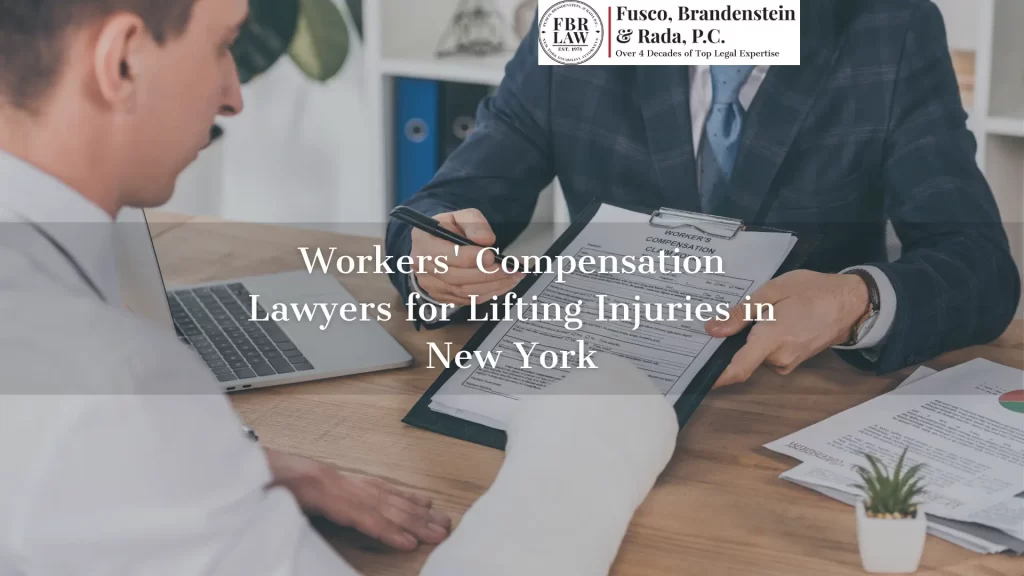
According to the U.S. Bureau of Labor Statistics, private-industry employers reported at least 79,360 lifting-related injuries in 2020. Lifting injuries can be painful, expensive, and disruptive to your life and livelihood. If you experience a lifting injury in the workplace, you need to hire an experienced attorney who understands these challenging injuries and the complexity of New York laws that protect injured workers.
That’s why you need to hire the New York workers’ compensation attorneys of Fusco, Brandenstein & Rada, P.C. to represent you. Our knowledgeable attorneys have helped New York workers for over 40 years to pursue full and fair workers’ compensation benefits for their workplace injuries. When you need a helping hand, you can count on Fusco, Brandenstein & Rada, P.C. to advocate for your rights throughout the claims process from start to finish. Call our office at 516-496-0400, or contact us online to begin the process today.
When, Where, and to Whom Do Lifting Injuries Happen?
Lifting injuries can happen in two ways: acutely, where you are injured after a specific incident of lifting a very heavy object at work; chronically, where you frequently must lift objects, heavy or not, at work.
Lifting injuries frequently happen at key joints in the body, such as wrists, shoulders, knees, and ankles. They also frequently afflict the neck and back, especially the lower back, which may be overtaxed when lifting heavy objects.
Lifting injuries can happen to anyone who finds themselves lifting a heavy object, but workers in certain industries are more susceptible to these injuries, such as:
- Construction workers
- Warehouse workers
- Healthcare workers
- Farm workers
- Factory workers
- Restaurant workers

What Is a Lifting Injury?
A lifting injury is not one specific injury but a category of musculoskeletal injuries caused by workplace lifting. The following injuries can be classified as lifting injuries:
- Vertebral injuries: Injuries to the spine are often very painful and debilitating. These injuries include compression fractures, in which a portion of the vertebra becomes compressed and fractures; burst fractures, in which a vertebra is crushed in all directions, often due to severe trauma; and vertebrae dislocations, in which the ligaments that protect the vertebrae are torn or overstretched, causing the vertebrae to move out of alignment.
- Herniated disk: Disks are rubbery pads between each vertebra. A herniated disk, also called a slipped, ruptured, or bulging disk, occurs when one of the rubbery pads between the vertebra tears or leaks. This can occur anywhere along your spine but when it comes to lifting injuries, it occurs more frequently in the lower back.
- Pinched nerve: A pinched nerve can occur in many places in the body whenever too much pressure is placed on a nerve by the surrounding tissue. Pinched nerves frequently occur in the back and cause pain, tingling, and weakness at the site of the pinched nerve and along the nerve pathway.
- Strained or torn muscles: A strained or torn muscle, also referred to as a pulled muscle, occurs when the fibrous tissue of the muscle or the tendon that attaches the muscle to bone is overstretched or torn. A strain can be minor, requiring just a few weeks of rest, but it could also be very serious, requiring surgery.
- Tendon and ligament injuries: Tendons are bundles of fibers that connect muscles to bones. Ligaments are elastic fibers that connect bones to other bones. Tendons and ligaments can be susceptible to acute or chronic injuries from lifting heavy objects. Common tendon injuries include strains, in which the tendon or the muscle that connects to the tendon is damaged; tendonitis, in which the tendon becomes inflamed; tendinosis, in which the tendon experiences microscopic tears from overuse; or ruptures, in which the tendon is completely torn. The most common ligament injury is a sprain, in which a ligament is stretched or torn.
If you or a loved one is seeking compensation for a lifting injury, contact us today. Fusco, Brandenstein & Rada, P.C. is here to help.
How to Seek Worker’s Compensation Benefits for a Lifting Injury
If you have experienced a lifting injury in the workplace, you might be eligible for workers’ compensation benefits through your employer’s insurance. According to New York state law, virtually all employers in the state must provide workers’ compensation benefits to their employees. After a lifting injury, it is important to follow these steps to pursue the compensation you need to recover:
- Immediately report your injury to your employer. Within 30 days of injury, notify your employer in writing of the injury with details such as the date, time, and location of the incident, what happened, and what injury you sustained. If 30 days have passed since your injury and you haven’t filed a report, you may lose your right to compensation.
- Seek medical treatment. Unless you suffered an injury requiring emergency care, you must seek medical treatment from a health care provider who is authorized by the New York Workers’ Compensation Board. Do not pay for medical treatment you received for this workplace injury. Retain all bills and receipts for medical care, prescriptions, and medically necessary equipment. These expenses should be paid by workers’ compensation benefits.
- Hire an experienced workers’ compensation benefits attorney. The legal process involved in filing a workers’ compensation claim is complex, and any error or misstep can jeopardize your right to benefits. That’s why you need to hire an attorney who knows New York state law and can handle the claims process for you while you focus on healing and recovery.
- Complete an Employee Claim (Form C-3) from the New York Workers’ Compensation Board. Your attorney can help you with this.
- Maintain all records related to your accident and injury. Documentation and evidence are important in workers’ compensation cases. Keep all medical bills, notices from your employer or insurance companies, and the New York Workers’ Compensation Board.
- Follow all doctor’s orders. It is important that you comply with your doctor’s orders during your treatment and recovery. Failure to do so could jeopardize your right to compensation.

Fusco, Brandenstein & Rada, P.C. Is Here to Help
If you experienced a lifting injury at work, you do not have to carry the burden of pursuing compensation alone. Hire experienced workers’ compensation benefits attorneys at Fusco, Brandenstein & Rada, P.C. to represent you and manage the claims process for you. Allow our team of knowledgeable, compassionate attorneys to handle your case while you focus solely on your health. Call Fusco, Brandenstein & Rada, P.C. today at 516-496-0400, or reach out to us online to learn more about how we can help you.
